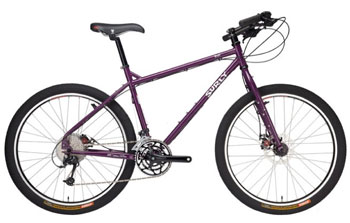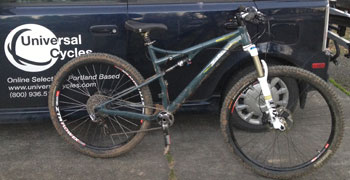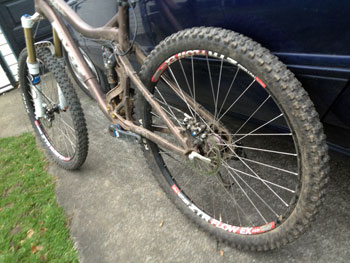View All Posts - General Bike (15) - Industry News (1) - Races & Events (4) - Retail Store Notes (4) - Site Updates (2)
Over the last several years, one of the funnest things to experience has been the amount of change in our industry. This seems to all derive from the engineers in our industry who constantly seem to have the idea that challenging the conventional wisdom for what is the "best" is a great idea. The amount of creativity that comes out through all the bike parts we ride absolutely astounds me. I don't think there has ever been a time that we have had so many incredible parts to choose from in every category of riding. One of the largest changes has been wheel size on the mountain bike end. It has left some people confused and others simply saying enough is enough. Like a cat drawn to a fresh bowl of food, I find myself on the side of "I HAVE to try that!" when it comes to new stuff. I try to tell myself not to, but, inevitably, curiosity gets the better of me, and I end up having to do a bunch of bike work to add something new. So, let's go through a few bits about wheel size. I am going to go through the sizes as they, generally, showed up on bikes.
 Mountain bikes, originally, settled on 26 inch rims in the early eighties. This comes from the availability of rims that were strong enough for mountain biking. Beach cruisers seemed to have the strongest, and widest, rims at the time. It made sense to use them, as they were available and had a good track record of being dependable. Additionally, there were some tires available that fit those rims. So, realistically, at the "birth" of the mountain bike, for lack of a better way to say that, 26 inch rims were the go to size. The size works well because the spokes are shorter than other options, leading to a stronger wheel. It is a good balance between strength of the wheel, rolling resistance and efficiency.
Mountain bikes, originally, settled on 26 inch rims in the early eighties. This comes from the availability of rims that were strong enough for mountain biking. Beach cruisers seemed to have the strongest, and widest, rims at the time. It made sense to use them, as they were available and had a good track record of being dependable. Additionally, there were some tires available that fit those rims. So, realistically, at the "birth" of the mountain bike, for lack of a better way to say that, 26 inch rims were the go to size. The size works well because the spokes are shorter than other options, leading to a stronger wheel. It is a good balance between strength of the wheel, rolling resistance and efficiency.
For many years, 26 inch was the size for mountain bike wheels. Suspension designs, amount of suspension travel, and overall bike geometry were based off of using a 26 inch wheel. 26 Inch wheels are still every common today, and still a great choice for many riders. Especially for longer travel "freeride" bikes and downhill bikes, it is arguable if any other wheel size should be used. Additionally, larger wheels lead to a "larger" bike in the sense of stand over height and being able to maneuver the bike. Shorter people still tend to prefer 26 inch wheels, as larger diameters can feel too big underneath them. 26 Inch wheels are also the most responsive to rider input over the larger wheel sizes available. This tends to make a 26 Inch wheel bike feel more playful and less "sluggish" when flying through fast singletrack. The bike tends to feel more "flickable", as some like to say, than bikes with a larger wheel size. But, if you are a taller person, sometimes 26 Inch bikes can tend to feel squirrelly. By the time I hit my overall height of 6'2", I just felt like I was falling off my 26" bike all the time (O.K., I'm not all that graceful. But, still. . . . )
 There are many people that helped bring this size into the forefront of mountain biking. The biggest one that comes to mind is Gary Fisher. Gary has always challenged the conventional norms ever since I can remember. Gary Fisher, along with others, pushed forward and brought us a new wheel size.
There are many people that helped bring this size into the forefront of mountain biking. The biggest one that comes to mind is Gary Fisher. Gary has always challenged the conventional norms ever since I can remember. Gary Fisher, along with others, pushed forward and brought us a new wheel size.
For all practical purposes, 29 Inch and 700c are the same size. The width of the rim may be different, but other than that, they are one and the same. This is logical, as the developers of 29 Inch needed a common rim size that was available to start playing more with mountain bike wheel size. Let it also be said that this wasn't a huge stretch, as cyclocross bikes also use 700c wheels. On the other hand, it was a huge stretch to challenge the conventional norm of mountain bikes. Not only was there the rim size to work with, but that meant that someone had to make a suspension fork and someone had to come forward to make tires, as well. If this size didn't work, the companies that would come forward would lose a bunch of money simply in the molds they needed to have to produce these products. But, those companies came through. WTB came through with tires. Marzocchi came through with forks. Other companies were hesitant and didn't adopt the new size (whoops!).
When the dust settled, 29 Inch mountain bikes claimed a strong foothold. Why? It's only 3 inches. Does it really matter that much? Well, as a taller rider, I can absolutely say yes. The larger wheel size has a few benefits. First of all, the larger wheels roll over stuff easier. If you roll over the same size rock, for instance, on a 26 and a 29 inch bike, the 29 inch bike will simply roll over it easier and faster. The rider will not feel it quite as much. Additionally, once at a good cruising speed, a 29 inch wheel will maintain it's rolling speed more efficiently than a 26 inch wheel. Simply put, it will take less energy to keep that wheel moving. But, for me, the biggest feature that 29 inch wheels provide is stability. My legs are long and I am tall. That means my center of gravity is right around the Empire State Building's roof. And, I don't like it. With a high center of gravity, I tend to fall over easily. Having 29 inch wheels underneath me gives me way more stability. I can slow down to a crawl on a very technical section and have the stability to make it through, rather than falling over. I often describe it as instead of feeling like a "Bear on a Bicycle", I feel like I am riding "in" the bike.
With all the benefits, as with everything in life, there are some drawbacks, though. 29 Inch wheels are not as strong as other wheel sizes. The spokes are longer, providing less lateral stability (think more wheel flex), and an overall weaker wheel. 29 Inch wheels need to use stronger spokes and lacing patterns than their smaller counterparts. It also takes more energy to get the larger wheel moving. So, from a stand still, or simply accelerating, takes more energy. And, perhaps, the most talked about disadvantage of a 29 inch wheel is the loss of maneuverability. A larger wheel takes more effort to control through tight twisty, fun, singletrack. Finally, to throw a monkey wrench in the whole thing, using 29 inch wheels requires completely different geometry and suspension design than 26" wheel. I would argue now that 29 inch full suspension bikes handle just as well as 26 inch bikes in terms of frame geometry and suspension design.
 This is the "new kid on the block" so to speak. Much credit goes to Kirk Pacenti who supported this wheel size before it really has become more mainstream. Again, like Gary Fisher, Kirk Pacenti is one of those people who challenges the norm.
This is the "new kid on the block" so to speak. Much credit goes to Kirk Pacenti who supported this wheel size before it really has become more mainstream. Again, like Gary Fisher, Kirk Pacenti is one of those people who challenges the norm.
This wheel size is so new, that we can't quite decide whether we want to call it 27.5" or 650b. But, as it sounds, it is right in the middle between 26 and 29 inch. Here we go again . . Why? Now, we are talking an inch and one half from 26 inch or 29 inch. It leads us to question even more whether it really matters. Again, I am going to say yes. I say that because, as I referred to above, I couldn't get this idea out of my mind. I have a really nice 26 inch long travel full suspension bike. But, it always has felt squirrelly underneath me. So, I did it. I was able to put 27.5/650b wheels on it. I used the same rims as my 29 inch rims, as to try to get the best perspective on any changes. Let it be said: I do not recommend doing this to your existing bike. Not all 26 Inch bikes, in fact most of them, will not accept the larger wheel size. Even my bike barely has enough clearance. But, it worked on my bike, and I had to appease the bike gods.
Did it change the bike? Yes. The first thing I noticed is that the bike was more stable. I didn't feel like I was going to tip over all the time if things got technical on the trail. The second thing I noticed was that it rolled faster. Yes, the bigger wheels rolled over everything just a little bit better. Not a huge amount, but just a bit better. Also, this middle size did not take away from the playfulness of the bike. It is still extremely responsive to rider input, more so than a 29 inch bike. Maneuverability of the bike is still incredible as I move through the incredible Northwest singletrack trails. The larger wheels have given me some of the benefits of a 29 inch wheeled bike. Being only half way up to the larger 29 inch size, technically, these wheels are stronger than 29 inch, and I do feel less lateral flex. I was able to use double butted spokes, as opposed to straight gauge, on these smaller wheels. That has saved some weight, which is really nice. Based on this experience, I do think that this wheel size is here to stay. It does offer some advantages over the other two wheel sizes. It remains to be seen if this is the "perfect" wheel size. But, in my opinion, without a doubt, it is a step in the right direction.